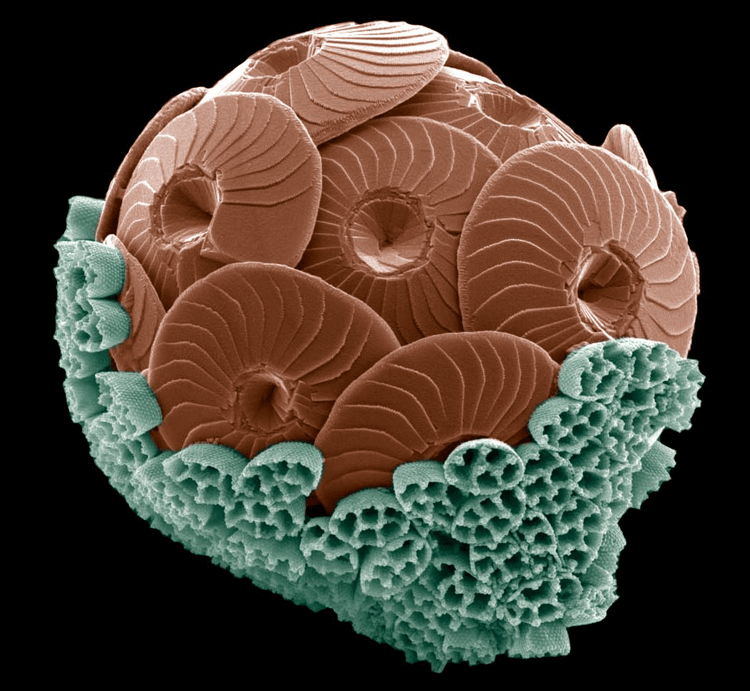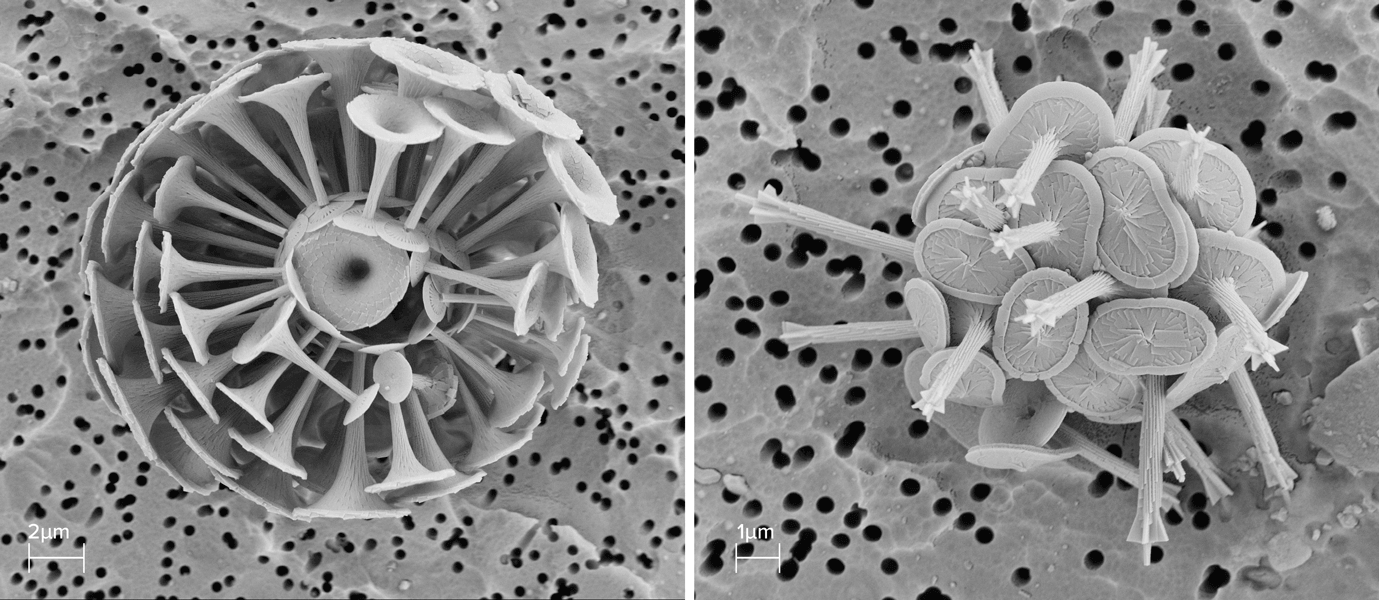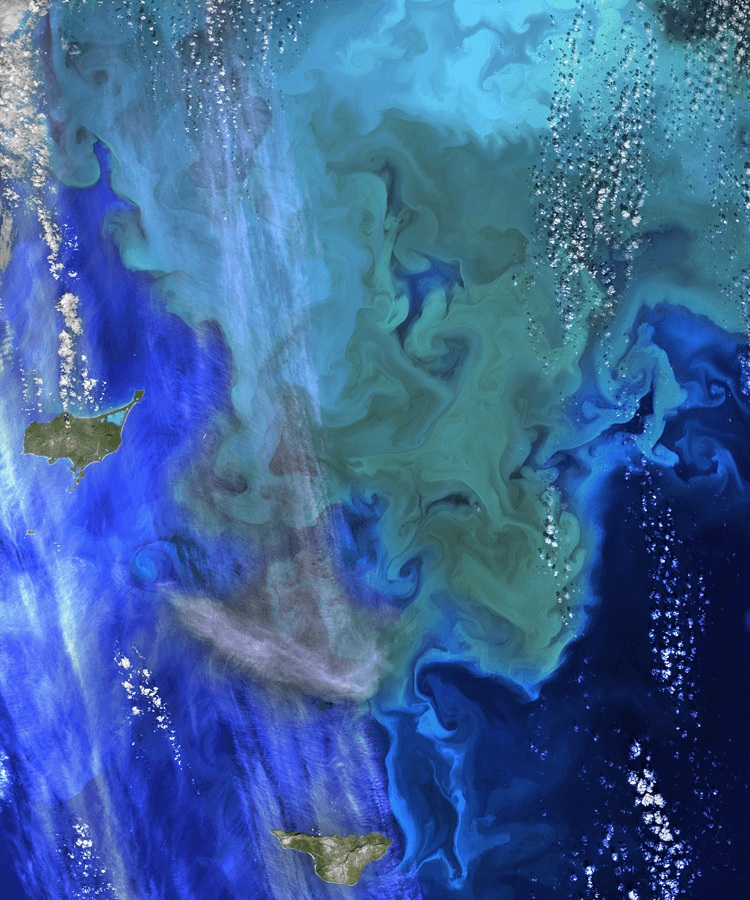
During coccolithophore blooms, the algae can become so prevalent that a single milliliter of water can contain as many as 100,000 individual limestone plates (or coccoliths). Some coccolithophore species produce two different types of plates, as shown in the false-colored image of the species Calcidiscus leptoporus, above. Balch says it’s rare to capture a cell in this transition from one set of plates to the other. “It’s truly amazing,” he says of the image, which a colleague made using a scanning electron microscope.
CREDIT: M. GEISEN ET AL / EUROPEAN JOURNAL OF PHYCOLOGY 2002
It was the summer of 1988 when early-career oceanographer Barney Balch spotted an unusually reflective patch of water in a satellite image of the Gulf of Maine. He and colleagues at the nearby Bigelow Laboratory for Ocean Sciences arranged a research cruise to investigate.
Ocean waters in this part of the temperate Atlantic typically run a deep sapphire hue. But this patch was much lighter, more typical of a tropical isle. “We got out in the middle of this thing and the water was basically turquoise in color from horizon to horizon,” Balch says. “You would have thought we had run aground in Bimini.”
The bright patch returned the next summer — a strikingly large, turquoise swirl spread across roughly 100,000 square kilometers. Water samples confirmed Balch’s suspicions of what had caused the bright patches: trillions of coccolithophores, tiny single-celled algae that sport reflective limestone plates made of the mineral calcite, as shown in the false-colored scanning electron micrograph above.
Those two blooms launched Balch, who still works at the Bigelow lab, on a career devoted to learning more about coccolithophores, one of the most abundant groups of phytoplankton in the world. As satellite imagery improved, researchers have identified and studied the blooms in ever more detail. And they have tracked several important ways the tiny organisms alter ocean chemistry, including the ability of the ocean to store carbon dioxide and thus keep it out of the atmosphere. So while each individual cell is no wider than a human hair, the sheer magnitude of these blooms gives coccolithophores an outsized impact on ocean chemistry and, in turn, global climate.
But as climate change makes the ocean more acidic and corrosive to limestone, some regions will become less hospitable to shell-forming organisms. Balch and colleagues are working to understand how ocean acidification may affect coccolithophore abundance and distribution around the world, and how these shifts could sway their role in regulating climate.

Coccolithophores grow in a variety of shapes and sizes, with trumpet-shaped structures found in Discosphaera tubifera (left) and spine-like protrusions in Rhabdosphaera clavigera (right). Balch collected these samples during an oceanographic cruise off the coast of New England in July 2018. The pockmarked material in the background is the filter he used to collect the microscopic algae.
CREDIT: BARNEY BALCH AND COLIN FISHER / BIGELOW LABORATORY FOR OCEAN SCIENCES
All photosynthetic organisms help moderate Earth’s thermostat to a certain extent by pulling the greenhouse gas carbon dioxide out of the atmosphere to make sugars. But coccolithophores help cool the planet in a variety of other distinctive ways related to their coccospheres, the chalky-white balls that surround their exteriors.
For one thing, these spheres shimmer so brightly that they can shield the ocean from the sun’s incoming radiation. “They are like little mirrors that are reflecting light back into space,” says Balch, who authored an overview of the shifting state of coccolithophores in the 2018 Annual Review of Marine Science. In the absence of the blooms, the open ocean is darker and more absorbent of the sun’s heat, he explains.
For another, each coccosphere is made of dozens of those ornate plates, called coccoliths, which are periodically shed into the ocean — and these free-floating microscopic discs can stick to and drag down pieces of feces, mucus and other decomposing material from the surface of the ocean to the seafloor. Since decomposition produces carbon dioxide, shuttling this material down to the deep reduces carbon dioxide emissions to the atmosphere and works against climate warming in yet another way.
In his office with a view of the Gulf of Maine, Balch shows a time-lapse video of one of these plates developing within a coccolithophore cell. Once fully formed, the disc is booted out to the cell’s exterior, and the alga continues building more. “Each of these coccoliths takes about two hours to make,” says Balch, grinning at the screen with an enthusiasm undulled by decades of painstaking study of these organisms.
Coccolithophores live in the ocean year-round, but their impressive blooms tend to explode around the summer solstice. “They are always there lurking in the background,” Balch says, “and it’s party time in the summer.” That’s mostly because nutrient levels at the surface of the ocean tend to decline around this time of year. Most phytoplankton rely on high levels of nutrients such as nitrate to survive, but coccolithophores can tolerate comparatively lower concentrations. So they take advantage of the early summer nutrient depletion to outcompete other plankton.

A bloom of coccolithophores and other marine algae off the coast of Alaska in the Bering Sea, captured by a NASA satellite. As satellite imagery has improved over the last several decades, researchers have been able to locate and study coccolithophore blooms in ever more detail.
CREDIT: NASA / LANDSAT 8
These seasonal blooms can span distances even more impressive than those in the Gulf of Maine, including one recurring bloom that has reached roughly half a million square kilometers across the North Atlantic Basin. The most extensive bloom in the world covers the entire Southern Ocean around Antarctica, about 16 percent of the entire global ocean when at its peak between the astral spring and fall. Balch and colleagues dubbed this the Great Calcite Belt when they discovered it on a series of cruises in 2011 and 2012.
Coccolithophores currently stand as one of the most abundant and environmentally influential groups of phytoplankton in the world — in fact, scientists think they are the largest contributors of limestone in the entire ocean. But their prevalence could waver as the ocean acidifies with climate change, says Marius Müller, an oceanographer at the Federal University of Pernambuco in Brazil who studies coccolithophore calcification. In acidic waters, he explains, coccolithophores will need to work harder to modify the chemistry of the seawater inside their cell to form calcite. And that extra energetic cost comes at the expense of other important tasks, such as growing and reproducing. This could allow non-shell-forming organisms to outcompete coccolithophores and other life forms struggling to build shells, he says.
In fact, a 2015 study based on satellite imagery of the Southern Ocean did find that coccolithophore shell production in the Great Calcite Belt may have decreased during the study period between 1998 and 2014, potentially due to acidification. Still, researchers have conflicting findings on how different species of coccolithophores in different places respond to ocean acidification. In one case, a study Balch coauthored in 2015 indicated that the North Atlantic population grew by nearly 20 percent from 1965 to 2010. The researchers hypothesize that the increase in atmospheric carbon dioxide over that time actually fertilized phytoplankton growth by promoting photosynthesis, and the benefits of that outweighed the effects of acidification in this location.
Laura Bretherton, an oceanographer at Mount Allison University in New Brunswick, Canada, says that this variability in response to acidification can also arise because other factors also influence growth — including ocean temperature, day length at different latitudes, and nutrient availability. “It goes to show how complex marine environments are,” she says. “It’s not going to be uniform.”
Understanding these complicated interactions will be critical in projecting broader changes in the planet’s future climate. But Müller and Balch say that the high environmental stakes aren’t the only things that draw them to this research. So does the striking beauty of coccoliths. The purpose of these ornate plates remains somewhat enigmatic, but theories suggest that they may help prevent viruses from infecting the cells or offer protection from tiny marine animals such as copepods that might like to eat them. “What better way,” Balch says, “to avoid being eaten by a voracious copepod than to cover yourself with rocks?”
Despite their ubiquity and importance in the ocean, coccolithophores remain relatively unfamiliar to the general public. Balch hopes to help shift that by publishing an e-book this year that will illustrate some of the many striking forms coccoliths take across the hundreds of species that exist.
As we click through images of these forms in his office, it’s clear that this is a labor of love. “I owe a great debt of gratitude to these things,” he says. “They are just so amazing.”




